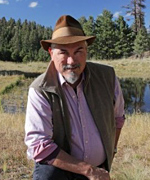 —Alan Dulaney
—Alan Dulaney
On January 31, 2019 — the same day he signed the Drought Contingency Plan legislation —Governor Ducey created the Water Augmentation, Innovation, and Conservation Council by issuing Executive Order 2019-02. The concept was to continue the work of previous initiatives and committees under one council structure. Inherent in this idea was the notion that the cooperation of all sectors that resulted in the DCP could persist to secure reliable water supplies for Arizona well into the future; momentum could be maintained. So, after almost a year of meetings, where do we stand?
At the December 3 quarterly meeting of the full Council, reports came in from various committees and working groups. The Long-Term Augmentation Committee had nothing to report. The Desalination Committee, however, has been looking at five to six potential areas for desalination of brackish groundwater, which offers considerable advantages over removing salts from seawater (proximity, cost, feasibility). Getting rid of the resulting brine remains the big problem. At their October meeting, the Committee heard a presentation from El Paso, Texas, which arguably has water resources problems as bad as Arizona’s could have been without 1980, and far more immediate. (Note: Texas has no Groundwater Management Act, thus no Assured Water Supply program, and certainly no Department of Water Resources; cities are left to scramble for water on their own). El Paso treats brackish groundwater and injects its brine, after recovering minerals such as gypsum. The Committee also heard that had the Yuma Desalting Plant been in operation this year; the water produced could have helped maintain elevations on Lake Mead above Tier 0 shortage levels for 2020 and freed up 192,000 acre-feet of water for Arizona users, if the Central Arizona Project had decided to forego system conservation for 2020. This committee looks like it is going somewhere.
The Non-AMA Groundwater Committee, in contrast, does not appear to have made much progress. Committee meetings to date have seen much posturing by various sectors, with some interests attempting to derail the process and others focused solely on their own regions. They have developed a list of 21 topics that they want to address but have not managed to prioritize them. The major sticking point appears to be the lack of good data, primarily in the form of well information. ADWR maintains the Wells55 database, but it is solely a registry of limited information (location, ownership, driller, and construction information), from only a single point in time. Wells55 was never intended to be a tool for evaluating long-term groundwater conditions across Arizona. The Groundwater Site Index database, also maintained by ADWR, would be a far better tool, even though it is much smaller. The Committee is also looking for more information on Best Management Practices around the state. The quest for usable data is daunting, rather like a very tiny cat eyeing an enormous rodent and wondering where to bite first.
The Post-2025 AMA Committee has carefully outlined a process building on the successes of the Groundwater Management Act over the last few decades in order to build a roadmap for a warmer and drier future. First, they will list challenges in each AMA, then agree on issues and relevant data to address the issues, and bring the results to the full Council. The goal remains to achieve and maintain safe yield for all AMAs except Pinal. Measuring safe yield was the subject of a presentation by ADWR, about 13 slides in.
Thus, some of the committees are making more progress than others, but the eyes of most participants — virtually all sectors interested in Arizona water are represented — are focused on the future. The DCP was only a temporary fix, drought persists, and water remains a major concern for the citizens and the economy.